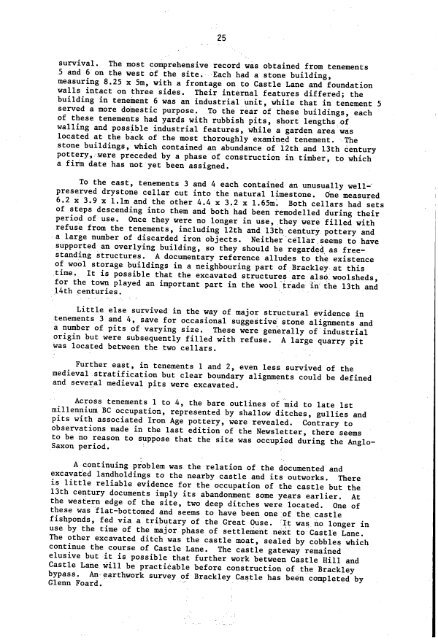CBA SMA\SMA 1983.PDF - Council for British Archaeology
CBA SMA\SMA 1983.PDF - Council for British Archaeology
CBA SMA\SMA 1983.PDF - Council for British Archaeology
You also want an ePaper? Increase the reach of your titles
YUMPU automatically turns print PDFs into web optimized ePapers that Google loves.
25<br />
survival. The most comprehensive record was obtained from tenements<br />
5 and 6 on the west of the site. Each had a stone building,<br />
measuring 8.25 x 5m, with a frontage on to Castle Lane and foundation<br />
walls intact on three sides. Their internal features differed; the<br />
building in tenement 6 was an industrial unit, while that in tenement 5<br />
served a more domestic purpose. To the rear of these buildings, each<br />
of these tenements had yards with rubbish pits, short lengths of<br />
walling and possible industrial features, while a garden area was<br />
located at the back of the most thoroughly examined tenement. The<br />
stone buildings, which contained an abundance of 12th and 13th century<br />
pottery, were preceded by a phase of construction in timber, to which<br />
a firm date has not yet been assigned.<br />
To the east, tenements 3 and 4 each contained an unusually wellpreserved<br />
drystone cellar cut into the natural limestone. One measured<br />
6.2 x 3.9 x 1.1m and the other 4.4 x 3.2 x 1.65m. Both cellars had sets<br />
of steps descending into them and both had been remodelled during their<br />
period of use. Once they were no longer in use, they were filled with<br />
refuse from the tenements, including 12th and 13th century pottery and<br />
a large number of discarded iron objects. Neither cellar seems to have<br />
supported an overlying building, so they should be regarded as freestanding<br />
structures. A documentary reference alludes to the existence<br />
of wool storage buildings in a neighbouring part of Brackley at this<br />
time. It is possible that the excavated structures are also woolsheds,<br />
<strong>for</strong> the town played an important part in the wool trade in the 13th and<br />
14th centuries.<br />
Little else survived in the way of major structural evidence in<br />
tenements 3 and 4, save <strong>for</strong> occasional suggestive stone alignments and<br />
a number of pits of varying size. These were generally of industrial<br />
origin but were subsequently filled with refuse. A large quarry pit<br />
was located between the two cellars.<br />
Further east, in tenements 1 and 2, even less survived of the<br />
medieval stratification but clear boundary alignments could be defined<br />
and several medieval pits were excavated.<br />
Across tenements 1 to 4, the bare outlines of mid to late 1st<br />
millennium BC occupation, represented by shallow ditches, gullies and<br />
pits with associated Iron Age pottery, were revealed. Contrary to<br />
observations made in the last edition of the Newsletter, there seems<br />
to be no reason to suppose that the site was occupied during the<br />
Saxon<br />
Angloperiod.<br />
A continuing problem was the relation of the documented and<br />
excavated landholdings to the nearby castle and its outworks. There<br />
is little reliable evidence <strong>for</strong> the occupation of the castle but the<br />
13th century documents imply its abandonment some years earlier. At<br />
the western edge of the site, two deep ditches were located. One of<br />
these was flat-bottomed and seems to have been one of the castle<br />
fishponds, fed via a tributary of the Great Ouse. It was no longer in<br />
use by the time of the major phase of settlement neXt to Castle<br />
The<br />
Lane.<br />
other excavated ditch was the castle moat, sealed by cobbles which<br />
continue the course of Castle Lane. The castle gateway remained<br />
elusive but it is possible that further work between Castle Hill and<br />
Castle Lane will be practicable be<strong>for</strong>e construction of the Brackley<br />
bypass. An earthwork survey of Brackley Castle has been completed by<br />
Glenn Foard.

















